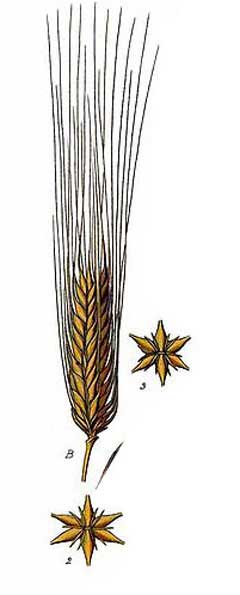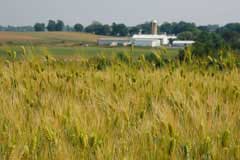 |
|
http://commons.wikimedia.org/wiki/File:386_Hordeum_vulgare_L.,_H._hexastichon_L.jpg |
 |
| http://en.wikipedia.org/wiki/User:Ram-Man |
Translate this page:
Summary
Physical Characteristics

 Hordeum vulgare is a ANNUAL growing to 1 m (3ft 3in) by 0.2 m (0ft 8in).
Hordeum vulgare is a ANNUAL growing to 1 m (3ft 3in) by 0.2 m (0ft 8in).
See above for USDA hardiness. It is hardy to UK zone 4 and is not frost tender. It is in flower from June to August. The species is hermaphrodite (has both male and female organs) and is pollinated by Wind.
Suitable for: light (sandy), medium (loamy) and heavy (clay) soils and prefers well-drained soil. Suitable pH: mildly acid, neutral and basic (mildly alkaline) soils. It cannot grow in the shade. It prefers moist soil. The plant can tolerates strong winds but not maritime exposure.
UK Hardiness Map
US Hardiness Map
Synonyms
Frumentum hordeum, Hordeum sativum, Hordeum nigrum, Hordeum durum, Secale orientale
Plant Habitats
Cultivated Beds;
Edible Uses
Edible Parts: Seed
Edible Uses: Coffee Drink Salt Sweetener
Seed - cooked as a whole grain or ground up and used as a flour for making bread, porridges etc[2, 7, 46, 183]. It has a low gluten content and so is unsuitable for making wheat-type breads[238, K]. The seed can be fermented into sourdough and many other fermented foods such as 'tempeh' and 'miso'[183]. The seed can also be sprouted and added to salads or the sprouted seed juiced and the juice drunk as a health-food drink[183]. The decorticated seed is called pearl barley. This is no longer viable since the decortication process damages the embryo. It is used in soups, stews etc[238]. Malt is obtained by sprouting the whole seed and then roasting it. The seed is then ground into a flour and boiled in water. The resulting liquid is very sweet and can be used in making beer or other drinks, and as a nutritious sweetener in various foods.[7, 46]. The roasted (unsprouted) seed is used as a coffee[46, 183] and a salt substitute.
References More on Edible Uses
Medicinal Uses
Plants For A Future can not take any responsibility for any adverse effects from the use of plants. Always seek advice from a professional before using a plant medicinally.
Abortifacient Cancer Carminative Demulcent Digestive Diuretic Emollient Expectorant
Febrifuge Galactofuge Hypoglycaemic Lenitive Nutritive Poultice Stomachic
The shoots are diuretic[218]. The seed sprouts are demulcent, expectorant, galactofuge, lenitive and stomachic[176, 218]. They are sometimes abortifacient[218]. They are used in the treatment of dyspepsia caused by cereals, infantile lacto-dyspepsia, regurgitation of milk and breast distension[176]. They are best not given to a nursing mother since this can reduce milk flow[176]. The seed is digestive, emollient, nutritive, febrifuge and stomachic[218]. It is taken internally as a nutritious food or as barley water (an infusion of the germinated seed in water) and is of special use for babies and invalids[238]. Its use is said to reduce excessive lactation[238]. Barley is also used as a poultice for burns and wounds[4, 46, 176, 218]. The plant has a folk history of antitumour activity[218]. The germinating seed has a hypoglycaemic effect preceded by a hyperglycaemic action[218]. Modern research has shown that barley may be of aid in the treatment of hepatitis, whilst other trials have shown that it may help to control diabetes[254]. Barley bran may have the effect of lowering blood cholesterol levels and preventing bowel cancer[254]. Other uses for bronchitis and diarrhoea, and as a source of folic acid and vitamin B12 and B6. Weight loss[301].
References More on Medicinal Uses
The Bookshop: Edible Plant Books
Our Latest books on Perennial Plants For Food Forests and Permaculture Gardens in paperback or digital formats.

Edible Tropical Plants
Food Forest Plants for Hotter Conditions: 250+ Plants For Tropical Food Forests & Permaculture Gardens.
More

Edible Temperate Plants
Plants for Your Food Forest: 500 Plants for Temperate Food Forests & Permaculture Gardens.
More

More Books
PFAF have eight books available in paperback and digital formats. Browse the shop for more information.
Shop Now
Other Uses
Biomass Mulch Paper
The stems, after the seed has been harvested, have many uses. They are a source of fibres for making paper, a biomass for fuel etc, they can be shredded and used as a mulch[141, 171].
Special Uses
Carbon Farming
References More on Other Uses
Cultivation details
Staple Crop: Balanced carb Under Development
Succeeds in most soils and in climates ranging from sub-arctic to sub-tropical[1, 171]. Easily grown in light soils[162]. Prefers a calcareous soil[7]. Best grown in a sunny position[238]. Barley first came under cultivation about 12,000 years ago[238]. It is widely cultivated in Temperate areas of the world for its edible seed, there are many named varieties[57, 183]. It succeeds further north than most other cereal crops (it succeeds in Norway at latitude 70° N[142]), and at higher altitudes (it is a staple crop in Tibet)[57, 238]. The Coeleste group contains the hull-less barleys. Although lower yielding than the type, these hull-less seeds are much easier to harvest making them a much easier crop to grow on a small scale[183].
Carbon Farming
-
Staple Crop: Balanced carb
(0-15 percent protein, 0-15 percent oil, with at least one over 5 percent). The carbohydrates are from either starch or sugar. Annuals include maize, wheat, rice, and potato. Perennials include chestnuts, carob, perennial fruits, nuts, cereals, pseudocereals, woody pods, and acorns.
-
Under Development
Plant breeders are actively working to domesticate these plants for cultivation, but they are not yet commercially available as crops. Examples include most of the perennial cereal grains.
References Carbon Farming Information and Carbon Sequestration Information
Temperature Converter
Type a value in the Celsius field to convert the value to Fahrenheit:
Fahrenheit:
The PFAF Bookshop
Plants For A Future have a number of books available in paperback and digital form. Book titles include Edible Plants, Edible Perennials, Edible Trees,Edible Shrubs, Woodland Gardening, and Temperate Food Forest Plants. Our new book is Food Forest Plants For Hotter Conditions (Tropical and Sub-Tropical).
Shop Now
Plant Propagation
Seed - sow in situ in March or October and only just cover the seed. Make sure the soil surface does not dry out if the weather is dry. Germination takes place within 2 weeks.
Other Names
If available other names are mentioned here
Native Range
TEMPERATE ASIA: Afghanistan, Cyprus, Egypt (Sinai), Iran, Iraq, Israel, Jordan, Lebanon, Syria, Turkey, Armenia, Azerbaijan, Kyrgyzstan, Tajikistan, Turkmenistan, Uzbekistan, China (Sichuan Sheng (west), Xizang Zizhiqu), Taiwan TROPICAL ASIA: India (northwest), Pakistan EUROPE: Greece (Kríti) AFRICA: Egypt (north), Libya (northeast)
Weed Potential
Right plant wrong place. We are currently updating this section.
Please note that a plant may be invasive in one area but may not in your area so it's worth checking.
Conservation Status
IUCN Red List of Threatened Plants Status :

Growth: S = slow M = medium F = fast. Soil: L = light (sandy) M = medium H = heavy (clay). pH: A = acid N = neutral B = basic (alkaline). Shade: F = full shade S = semi-shade N = no shade. Moisture: D = dry M = Moist We = wet Wa = water.
Now available:
Food Forest Plants for Mediterranean Conditions
350+ Perennial Plants For Mediterranean and Drier Food Forests and Permaculture Gardens.
[Paperback and eBook]
This is the third in Plants For A Future's series of plant guides for food forests tailored to
specific climate zones. Following volumes on temperate and tropical ecosystems, this book focuses
on species suited to Mediterranean conditions—regions with hot, dry summers and cool, wet winters,
often facing the added challenge of climate change.
Read More
Expert comment
Author
L.
Botanical References
117
Links / References
For a list of references used on this page please go here
Readers comment
© 2010, Plants For A Future. Plants For A Future is a charitable company limited by guarantee, registered in England and Wales. Charity No. 1057719, Company No. 3204567.